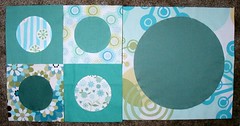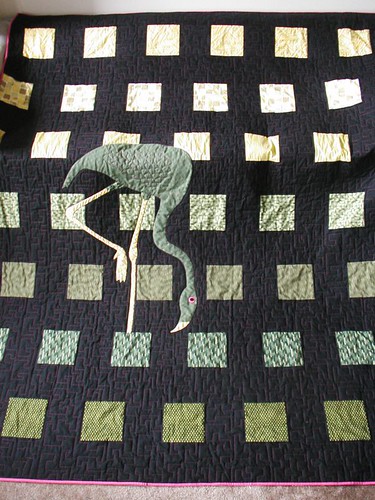Books like these show the quilts being made before the multimillion-dollar quilting industry really took hold. They perfectly suit my taste for quilts that are neither traditional nor art quilts—and, well, it's pretty clear that my aesthetic is heavily retro.
It's amazing to see the quilts that came together without the thousands and thousands of bolts of fabric made specifically for quilting that we have access to today. Virginia Avery wrote in 1978 in her Big Book of Applique
What a feast of fabrics we have today! Never before has there been such plenty, and never before has the choice been so difficult.Our options have only grown.
Click on the square pictures to see bigger versions. I've picked out some of the photos that especially intrigued me, but if you're thinking of tracking down copies for yourself, keep in mind that there are usually only a handful of color plates scattered throughout each book; most of the photos are black and white.
The Big Book of Applique
 Riddle me this: if everybody in the 1970s quilt revival was making these wild appliqué quilts, what happened to them? OK, so maybe it wasn't everyone, but there seems to be a certain genre of appliqué quilt that you just don't see at the flea market.
Riddle me this: if everybody in the 1970s quilt revival was making these wild appliqué quilts, what happened to them? OK, so maybe it wasn't everyone, but there seems to be a certain genre of appliqué quilt that you just don't see at the flea market. I'd once toyed with the idea of doing something similar myself, but seeing it done here, I don't think I'd have the patience.
I'd once toyed with the idea of doing something similar myself, but seeing it done here, I don't think I'd have the patience.I nearly didn't bother with Patchwork Simplified
 The author's real talent lies in her colour and fabric choices, particularly in composing these small pillows of tiny squares. It seems quilters had access to crazier fabrics in Europe than in America, where gingham, stripes, small florals, and the like were still the dominant prints used.
The author's real talent lies in her colour and fabric choices, particularly in composing these small pillows of tiny squares. It seems quilters had access to crazier fabrics in Europe than in America, where gingham, stripes, small florals, and the like were still the dominant prints used. Another striking composition, and a creative way to use dot fabric. I love the asymmetry. But why on earth wouldn't you just machine-piece it??
Another striking composition, and a creative way to use dot fabric. I love the asymmetry. But why on earth wouldn't you just machine-piece it?? This, on the other hand, demonstrates the versatility of English piecing. It would certainly be a trick to do this with standard machine-piecing.
This, on the other hand, demonstrates the versatility of English piecing. It would certainly be a trick to do this with standard machine-piecing.The Quiltmaker's Handbook
 This is typical of the author's quilting style: a geometrical approach that isn't wholly removed from traditional quilt design but is fresh in colour and layout. The notches in the sides and at the corners (Battlestar Galactica cut corners, anyone?) are also typical of the not-quite-square quilts he shows in the book.
This is typical of the author's quilting style: a geometrical approach that isn't wholly removed from traditional quilt design but is fresh in colour and layout. The notches in the sides and at the corners (Battlestar Galactica cut corners, anyone?) are also typical of the not-quite-square quilts he shows in the book. Another interesting shape in a nice colour palette.
Another interesting shape in a nice colour palette. I liked the dynamism of this deceptively simple quilt as well as the way it ignores traditional block structure. The allover quilting design looks ahead of its time.
I liked the dynamism of this deceptively simple quilt as well as the way it ignores traditional block structure. The allover quilting design looks ahead of its time.Mark Lipinski recommended Better Homes and Gardens Patchwork and Quilting
 The colours and irregular stripes of this one reminded me of the Any Way You Slice It quilt in Denyse Schmidt's book
The colours and irregular stripes of this one reminded me of the Any Way You Slice It quilt in Denyse Schmidt's book Another example of the strong, colourful, graphic appliqué of the '70s. It's so rare now to see such a detailed quilt made entirely of solids.
Another example of the strong, colourful, graphic appliqué of the '70s. It's so rare now to see such a detailed quilt made entirely of solids. This quilt is the cover model, a modern take on Grandmother's Flower Garden. I like the pattern's somewhat vague layout instructions; patterns today sometimes give too-precise directions to fake a haphazard appearance that's better done by eye.
This quilt is the cover model, a modern take on Grandmother's Flower Garden. I like the pattern's somewhat vague layout instructions; patterns today sometimes give too-precise directions to fake a haphazard appearance that's better done by eye.Also a bit more of a pattern book, The Great Noank Quilt Factory
 I liked this simple quilt for its mix of print and pattern, piecing and appliqué.
I liked this simple quilt for its mix of print and pattern, piecing and appliqué. These chevrons make quite a bold statement. The impressive colour gradation is in the quilt, not just a flaw of my admittedly crap camera.
These chevrons make quite a bold statement. The impressive colour gradation is in the quilt, not just a flaw of my admittedly crap camera. Another geometric wonder.
Another geometric wonder. And a word of warning: please do not subject your children to these terrifying
And a word of warning: please do not subject your children to these terrifying The best vintage quilting book I've found, though, is Quilts and Coverlets
















